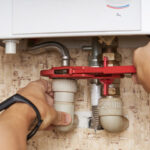Your Water Heater Denver is a significant appliance and an essential home part. Preventative maintenance and regular inspection are the best ways to ensure that the equipment lasts as long as possible.
Whether you have a conventional tank or an on-demand hybrid electric heater, you should understand how each type works.
A water heater is one of the most essential appliances in any home. It turns the cold water that travels through your city pipes into warm and hot water for showering, washing dishes, and other household uses. It’s easy to take a water heater for granted until it stops working or isn’t as energy efficient as it should be. That’s why it’s important to know the different types of water heaters available so you can find a model that best fits your needs and your home.
The traditional tank water heater is the most common type of unit installed in homes today. It consists of a large, insulated tank that holds 30 to 80 gallons of water. The tank is heated by a gas burner or heating elements. The thermostat monitors the temperature of the incoming cold water, and when it drops below the desired level, it signals the burner to turn on.
While this is a very reliable and affordable option for many families, there are some drawbacks to tank-style heaters. For one, they only hold a limited amount of water at any given time, so you may run out of hot water if everyone in the house is using it at the same time. In addition, tank-style units use gas or electricity day and night to maintain the water temperature, even when no one is using it, which can result in costly energy bills.
Another option is the heat pump water heater. This model works similarly to an air conditioner, except instead of moving heat from the surrounding area to the water, it moves heat from the hot coils into the cold water. It’s more expensive than a gas or electric heater, but it can be up to three times as energy-efficient.
Installation
A water heater requires a drain valve, gas shutoff, GFCI electrical outlet, and hot water service lines. Depending on the type of water heater you choose, you may also need an expansion tank or pressure relief valve. If your home doesn’t have a gas line connected to the water heater, it can be expensive to bring one in.
A gas tank water heater can use natural or propane gas, and must be vented to the outside through a flue pipe. The venting system is a major safety feature that prevents carbon monoxide poisoning from the combustion process.
Electric storage tanks have more size options than gas tanks, and offer energy efficiency features that boost their performance, such as an insulated cover, a thermal factor of at least 95%, and an intermittent pilot. They’re also less prone to corrosion and rust.
If your water heater isn’t producing hot water, the first thing to check is that its circuit breaker hasn’t tripped. If it has, simply switch it back on. If your water heater is leaking, it could be due to a faulty temperature sensor or a failed heating element.
In a typical tank-type water heater, cold water flows through a dip tube to the bottom of the tank and is heated by a burner or electric element. The warm water rises through the pipe to your hot water service line, which delivers it to your appliances.
The tank also has an insulated lid that keeps the water inside a safe temperature range. It’s important to maintain the proper water temperature for your family, as excessive temperatures can damage your plumbing and create a health risk.
Periodic water heater maintenance is critical to extend its lifespan and optimize its energy efficiency. Check your owner’s manual for specific recommendations. When it comes time to replace your water heater, consider hiring a professional for a tankless or electric installation, which generally takes less time and costs less than a gas installation.
Energy Efficiency
If your water heater is older and inefficient, you may save energy by upgrading to a new model. The latest models use about half as much energy as traditional units. And if you choose to go with an electric tankless unit, you’ll eliminate standby energy losses that occur when your hot water flows through a conventional storage tank.
You can also minimize energy loss by installing low-flow showerheads that reduce the amount of hot water delivered per minute. And if your hot water demand is high at one end of your home and your water heater is at the other, you can install a hot water recirculation system that limits the distance water travels to get to its destination.
Another option is an electric point-of-origin water heater, which is installed at the fixture where you want instant hot water (e.g., kitchen and laundry appliances). These units are smaller than tankless models and can be located closer to the fixtures, which cuts energy losses from piping. However, they require more electricity to raise the temperature of the water, so make sure your electrical service can handle a larger load before you invest in this option.
When shopping for a water heater, look for the label that shows its energy efficiency rating on a scale of A to G. The higher the rating, the more efficient the unit. Also, look for the Energy Factor, which tells you how many kilowatt-hours it will take to heat a specified volume of water under test conditions that simulate heavy use.
A newer, more efficient model can help you cut your energy bills and reduce your carbon footprint at the same time. And if you switch to a gas model, you can use clean natural gas that produces fewer emissions than fossil fuels and doesn’t contribute to global warming.
The most efficient electric water heaters have a thermal efficiency of up to 97%, meaning that for every kilowatt-hour they consume, they produce nearly nine more kilowatt-hours in usable hot water. And if you’re interested in cutting your environmental impact even further, consider switching to a heat pump water heater (HPWH). These units use the same technology as refrigerators to keep their contents cold but capture and reuse energy from the air to heat your water.
Maintenance
Taking simple steps to maintain a water heater can prevent major repairs and extend its life. Even tankless units require maintenance from time to time. A professional technician can inspect and perform routine maintenance to ensure that your water heater is operating safely and efficiently.
Both gas and electric heaters should be flushed annually to remove rust, scale and other metal gunk that builds up inside the tank over time. This will prolong the life of your water heater by keeping it from becoming damaged or overheated.
Draining the water heater can also help. This is especially important with tankless units that don’t have the natural sediment that accumulates in tank-style units.
A flush can also prevent mineral deposits from building up on the bottom of the tank, reducing efficiency and potentially shortening the life of the heater. In addition, a professional technician can also perform a bacteria flush to prevent bad smells and other buildup in your tank.
If you plan to do a water heater flush yourself, make sure that the area around your unit is clear of flammable or combustible materials and that you have the right equipment for the job. You’ll need a garden hose, a power drain valve (situated atop the water heater and often indicated by a blue handle) and a water heater drain valve, which is located at the bottom of the unit. Lastly, you’ll need a wrench to loosen and drain the tank.
After draining the water, you’ll need to turn off the electricity to your unit (for electric heaters) or the gas line to your unit. Some gas water heaters will require you to relight the pilot light following the manufacturer’s instructions.
Be sure to test the pressure-relief valve on your tank to see if it works correctly. This valve is designed to open if the water heater becomes overpressurized, protecting your home from explosions and other safety hazards. The valve is easy to check; simply place a bucket under the discharge pipe on the top or side of the unit and lift the lever on the pressure-relief valve.

